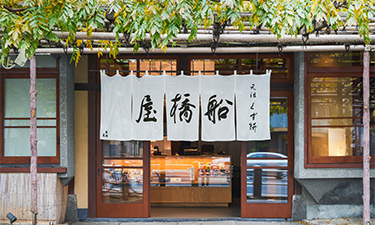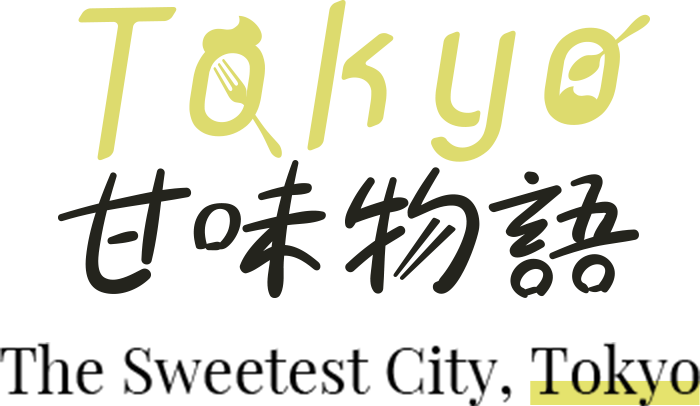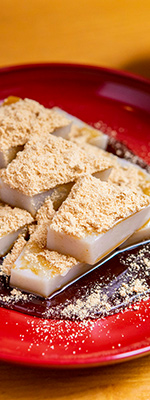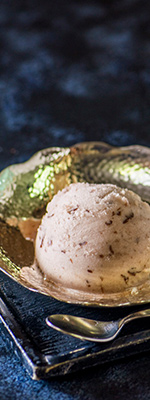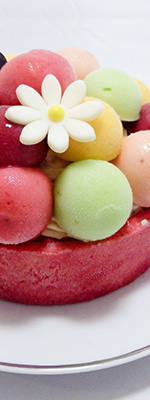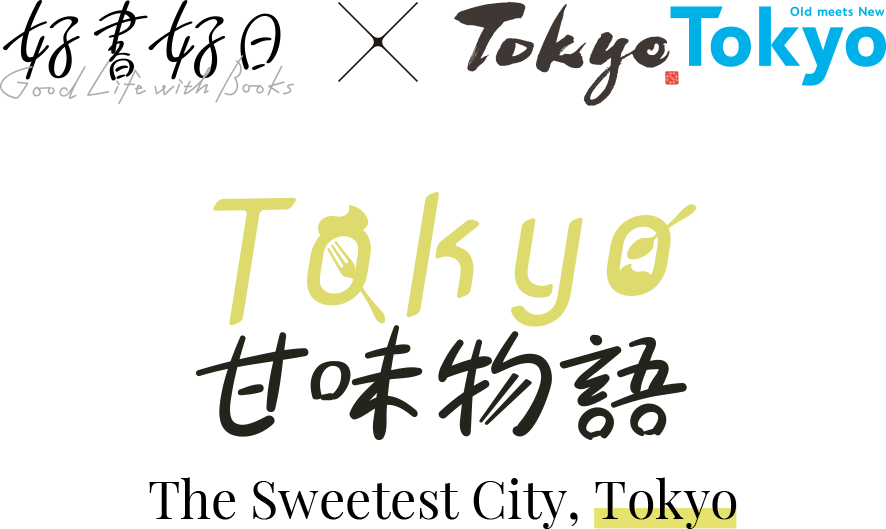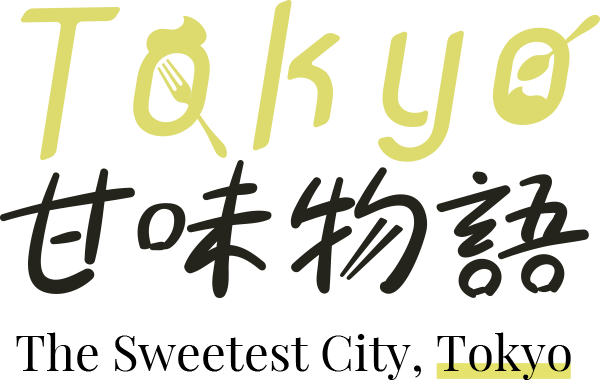
Popular with Great Writers
~ Soseki, Ogai, Akutagawa ~
that was Popular with
Great Writers
~ Soseki, Ogai, Akutagawa ~
Some of Japan’s greatest writers loved Tokyo confectionary. Many distinguished writers seem to have had a sweet tooth and were attracted by the appeal of certain confections, the unchanging taste of which they could enjoy at long-established confectioners. These writers who appear moody and hard to please in the photographs may have worn a different expression with confectionary in front of them. Here, we take a look at the relationship between great writers and Japanese confectionary and some of their favorite items.
[Text: Emi Iwamoto/Photographs: Chiemi Kitahara]
Taste that conjures up memories of friends
“‘... Let’s go. How about Ueno? Let’s go try some of Imozaka’s famous dumplings. Have you ever tried those dumplings? You, too, Mrs. Sneaze, sometime you really ought, if only just once, to try them. They’re beautifully soft and even more beautifully cheap. They serve saké as well.’ Tatara was still babbling away about dumplings when my master, his hat on his head, was ready on the doorstone waiting to leave...
Myself, I need rest. There’s no conceivable reason why I should keep watch upon, still less record, how my master and Tatara behaved at Ueno Park, how many plates of dumplings they consumed, and what other pointless happenings transpired. In any case, I lack the energy to trail along after them. I shall therefore skip all mention of their afternoon doings and, instead, relax.”
(From “Wagahai wa Neko de Aru (I Am a Cat)” by Natsume Soseki)
The sweet rice dumplings that are mentioned in one passage of Natsume Soseki’s “Wagahai wa Neko de Aru (I Am a Cat)” are dumplings made by “Habutae Dango,” which has its main shop in Nippori. With a long history, the first shop was established as “Fujinoki Chaya” at the bottom of Imozaka hill (location of the current main shop) in 1819 (Year 2 of the Bunsei period). Because the rice dumplings sold there were delicate, like “Habutae” (A Japanese fine silk), the trade name of the shop was changed to Habutae.
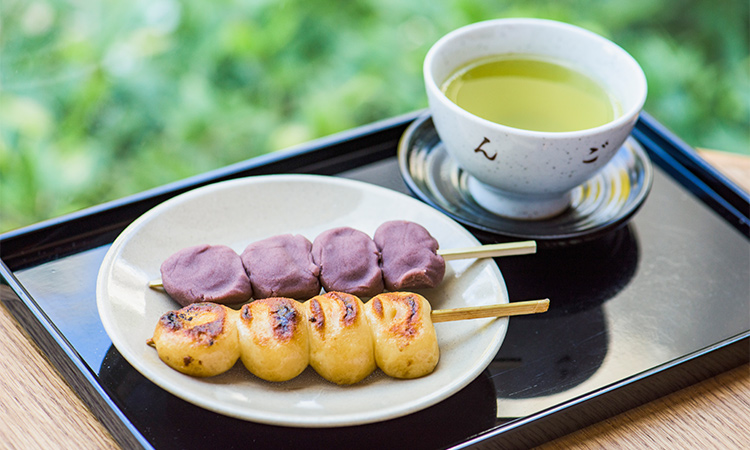
It is said that the reason for the flat shape of the dumplings is that ordinary people feared eating round dumplings that were offered to the gods. Supposedly, another reason is that it easier to heat dumplings thoroughly if they are flat.
From olden times, dumplings topped with Koshian (smooth sweet azuki bean paste) have a slightly sweet taste that brings out the real flavor of the azuki beans. On the other hand, dumplings “coated with soy sauce twice and grilled twice” are recommended to people who enjoy alcohol for the slightly sweet taste of rice combined with the taste of soy sauce. There is also an anecdote of Okakura Tenshin, known as the father of modern Japanese art, forgetting to go home after becoming intoxicated when he ate these dumplings as a side dish with sake.
Habutae Dango are known to have been a favorite of Masaoka Shiki, a friend of Soseki, and, in his “Gyoga Manroku (Stray Notes While Lying on My Back),” a diary he wrote and bound in his sick bed, he noted “I eat three skewers of dumplings topped with Anko and grilled one coated with soy sauce (This causes trouble).
Shuichi Sawano, the seventh-generation proprietor of Habutae Dango, says, “Although there are no clear records of Soseki visiting the shop, it seems likely that he often did so since the name Habutae Dango appears in his works. It may have been Soseki who told Shiki about Habutae Dango.”
“Wagahai wa Neko de Aru (I Am a Cat)” first appeared in the literary journal “Hototogisu” in January 1905 (Year 38 of the Meiji era), several years after Shiki’s death. It may be that Soseki recalled his dead friend as he wrote.
[Location] 5-54-3 Higashi Nippori, Arakawa-ku, Tokyo
[Access] 5-minute walk from Nippori station
[TEL] 03-3891-2924
[Hours / fixed holidays]
9:00 – 17:00 (LO: 16:45) / Open year-round
[Official site] https://habutae.jp/
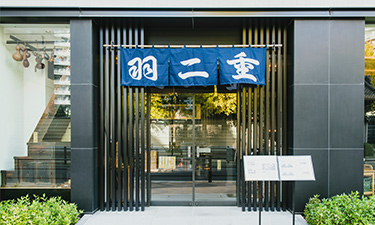
Fastidious about food as a physician
After studying bacteriology in Germany, Mori Ogai, also active as a military physician, developed an extreme germ phobia. Never eating raw vegetables or fruits, it is said that Ogai was extremely fussy about food.
As such, it seems that Ogai also had a sweet tooth, to the extent that records remain in essays by his children telling how Ogai loved to eat “Manju Chazuke (rice topped with Manju (buns with an Anko filling) with green tea poured over it),” a dish he devised himself.
“He would break the bun into four pieces with his clean hands with white fingernails, place one pieced on the rice and pour green tea over it.”
(From “Bimbo Savarin (Poor Savarin)” by Mari Mori)
“He liked eating sweet things with rice and, while I couldn’t possibly, he used to eat the rice topped with Manju with green tea poured over it.”
(From “Bannen no Chichi “My Father in his Later Years” by Annu Kobori)
With a tendency toward an unbalanced diet, as well as Manju Chazuke, another of Ogai’s favorites was “Ganso Ogura Ice Cream (Original azuki bean ice cream)” sold by the confectioner’s “Kanmidokoro Mitsubachi.”
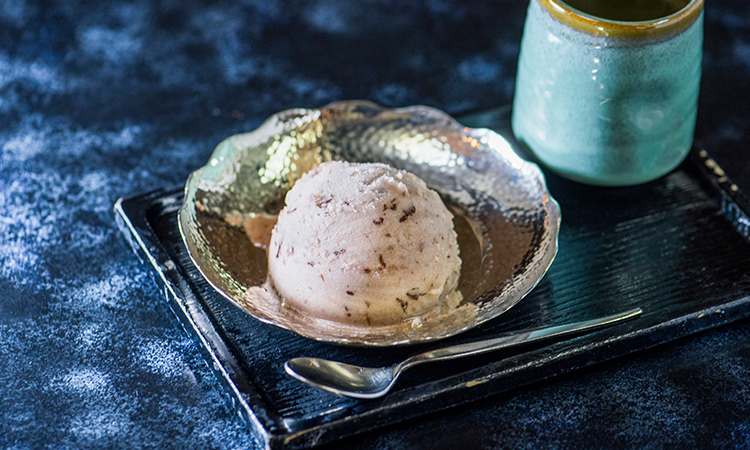
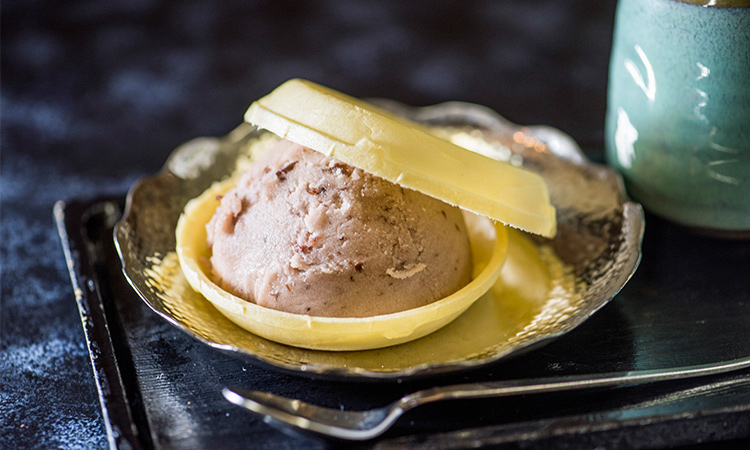
“I’ve heard that Ogai used to visit the shop frequently to have azuki bean ice cream from the days of the founder, my great grandmother. In those days, one scoop of ice cream was served on a silver dish,” says Yuko Shimada, the fourth-generation proprietor.
Established in Yushima in 1909 (Year 42 of the Meiji period), the shop originally sold ice. Ogura Ice Cream was a product of chance. In cool summers, grated ice topped with azuki beans didn’t sell well, so the leftover beans were put into tubs, sprinkled with salt and stored on ice, and, supposedly, when it was noticed that the beans on the outside became slightly frozen, someone tried eating some. Because they were crunchy and tasted good, they were blended in a mixer with some ice cream that had just been bought in, and the result was Ogura Ice Cream.
With the basic ingredients unchanged since those days, only sugar, salt and water are added to the azuki beans to produce ice cream with the distinctive taste of the beans. Despite its smooth and soft texture, it’s great that the ice cream is completely free of butterfat.
It may be the fact that the ice cream is easy on the body is one of the reasons that Ogai, who was so fussy about food, found it so appealing.
[Location] 3-38-10 Yushima, Bunkyo-ku, Tokyo
[Access] 2-minute walk from Yushima station
[TEL] 03-3831-3083
[Hours / fixed holidays]
Shop: 10:00 – 21:00 / Tea shop: 10:30 – 20:00
(From 11:00 on weekdays from November through February for both)
Open year-round (with some temporary closures)
[Official site] https://www.mitsubachi-co.com/
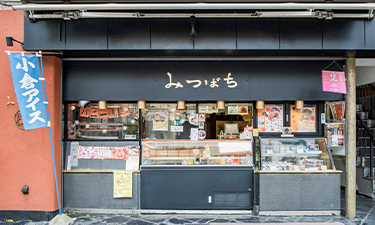
Confection that brought happiness to a writer with a mental disorder
Unable to bear “a vague insecurity about the future,” Akutagawa Ryunosuke took his own life at the young age of 35 years old. While the works of his later years, which give the impression of morbid fears, an image seemingly at odds with images of sweetness, Akutagawa did find that a certain confection brought him some happiness; “Kuzumochi” sold by “Funabashiya.”
Funabashiya was founded in 1805 (Year 2 of the Bunka period) on the grounds of Kameido Tenjin Shrine. The name of the shop derives from Funabashi in Chiba Prefecture, the home of the Kansuke, the first-generation proprietor. Mochi made at the shop for visitors to the shrine won high acclaim and came to be called “Kuzumochi,” an item that became a specialty of Edo.
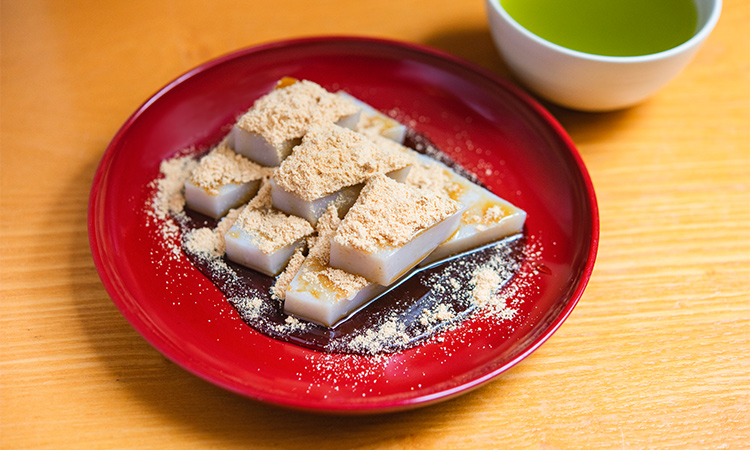
After fermentation of wheat flour by lactic acid bacteria for 450 days, the resulting milky white Kuzumochi is steamed, giving it a delightful elastic, springy texture. Kuromitsu, brown sugar syrup made using brown sugar from Hateruma in Okinawa is secret recipe of Funabashiya. To make sure that it is not overwhelmed by the rich taste of Kuromitsu syrup, Kinako, roasted soybean flour that is sprinkled over the syrup, is made from coarsely ground soybeans to produce an aromatic fragrance.
To allow customers to enjoy the freshly made product, no preservatives or other additives are used. The combined tastes of Kuzumochi, made sparing no time or effort, Kinako and Kuromitsu can be enjoyed for no more than two days. Such determination is reminiscent of the very best of Edo.
The honeymoon between Funabashiya’s Kuzumochi and Akutagawa began long before he became a writer. Shortly after his birth, Akutagawa was removed from his mother’s home and spent his youth at Ryogoku, a place not far from Kameido Tenjin Shrine.
According to Ayame Tsukioka, publicist for Funabashiya, “They still say that, during his student days, Akutagawa would skip physical education classes and come to eat Kuzumochi.”
About 20 later, in an essay entitled “Honjo Ryogoku” published in a newspaper in his very last years, he wrote of a visit he made to Funabashiya for the first time in a while.
“After leaving ‘Kameido Tenjin Shrine,’ we talked about going to ‘Funabashiya’ for some Kuzumochi. However, being away from Honjo for a long time, it was difficult for me to find ‘Funabashiya.’”
(From “Honjo Ryogoku” by Ryunosuke Akutagawa)
Pretending to be from the provinces, Akutagawa asked one of the townsfolk the whereabouts of the shop. Even though he was in his very last years, the cheerful upbeat mood he felt may have been because he recalled the days of his youth when he still felt hope. Finally finding his way to the shop, Akutagawa no doubt felt a brief happiness as he chewed the Kuzumochi.
[Location] 3-2-14 Kameido, Koto-ku, Tokyo
[Access] 10-minute walk from Kameido or Kinshicho stations
[TEL] 03-3681-2784
[Hours / fixed holidays]
9:00 – 18:00 (Tea shop: 9:00 – 17:30, LO: 17:00)
Open year-round
[Official site]https://www.funabashiya.co.jp/
